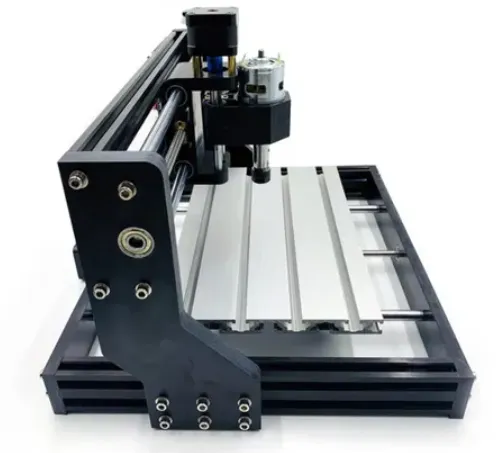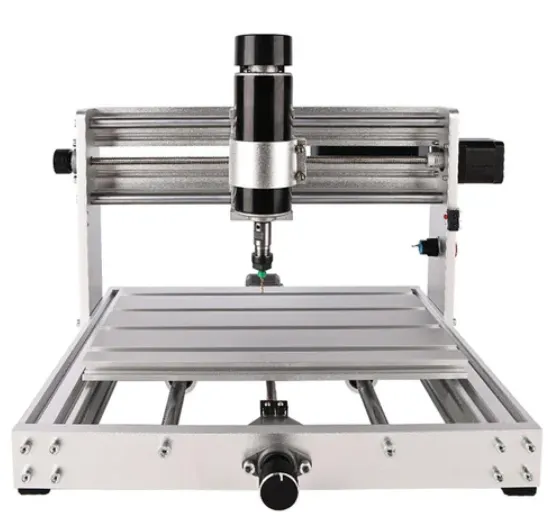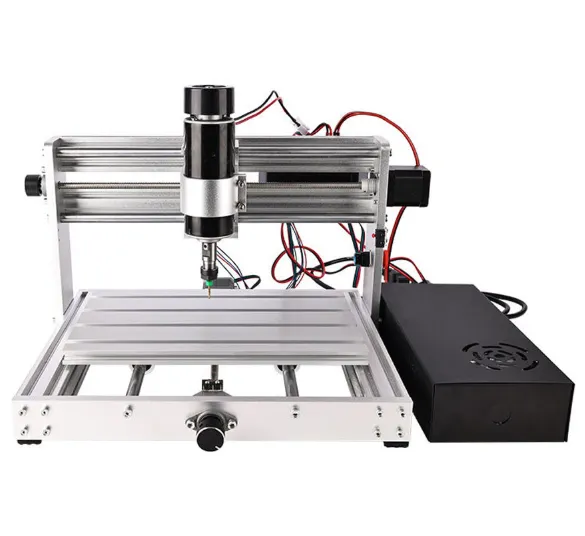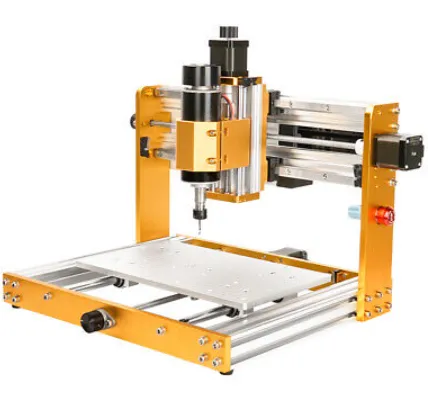The 3018 500W CNC router represents an entry-level industrial machining solution that combines compact dimensions with capable performance for small-scale production and prototyping applications. This desktop-class machine features a working envelope of 300mm × 180mm × 45mm (X/Y/Z axes), constructed from aluminum alloy extrusions with steel linear rails providing stable guidance for all axes of motion. The system’s 500W DC spindle operates within a speed range of 7,000-24,000 RPM, delivering sufficient torque for machining soft metals (aluminum, brass), engineered plastics (acrylic, polycarbonate), and wood products (hardwoods, MDF, plywood). Actual cutting performance varies by material, with recommended feed rates of 300-600 mm/min for wood and 100-300 mm/min for aluminum when using appropriate carbide end mills (typically 2-4mm diameter).
 Motion control is managed by NEMA 17 stepper motors with 1.8° step angles, achieving positioning accuracy of ±0.1mm under normal operating conditions when properly calibrated. The machine utilizes M8 lead screws with 2mm pitch on all axes, providing theoretical resolution of 0.0125mm per microstep (with common 1/16 microstepping drivers). In practical applications, backlash compensation of 0.05-0.1mm is typically required to maintain dimensional accuracy, particularly when changing cutting direction. The electrical system operates on 24V DC power with peak current draw of 5A, requiring proper ventilation during extended machining sessions to prevent driver overheating.
Motion control is managed by NEMA 17 stepper motors with 1.8° step angles, achieving positioning accuracy of ±0.1mm under normal operating conditions when properly calibrated. The machine utilizes M8 lead screws with 2mm pitch on all axes, providing theoretical resolution of 0.0125mm per microstep (with common 1/16 microstepping drivers). In practical applications, backlash compensation of 0.05-0.1mm is typically required to maintain dimensional accuracy, particularly when changing cutting direction. The electrical system operates on 24V DC power with peak current draw of 5A, requiring proper ventilation during extended machining sessions to prevent driver overheating.
The 3018’s GRBL-based control system accepts standard G-code instructions via USB connection, compatible with common CAM software packages including Fusion 360, Vectric, and EstlCAM. Machine parameters include maximum travel speed of 2,000 mm/min (rapid moves) and recommended cutting speeds not exceeding 800 mm/min for optimal tool life. The spindle’s ER11 collet system accommodates tool shanks up to 6.5mm diameter, with runout typically measuring 0.02-0.05mm when properly maintained. Cooling is passive for the spindle (air-cooled) while stepper motors incorporate basic heat sinks, limiting continuous duty cycle to approximately 4 hours before recommended cooldown periods.
Industrial applications of the 3018 500W model focus primarily on prototyping and small-batch production where its size constraints are acceptable. Common uses include PCB milling (trace isolation with 0.2-1.0mm V-bits), wax mold fabrication for jewelry casting (using 2-3mm ball nose end mills), and precision engraving of aluminum tags (with 30° engraving bits at 12,000-18,000 RPM). The machine demonstrates particular effectiveness in educational environments, where its safety features (emergency stop, enclosed design when optioned) and simplified operation facilitate CNC training. Material removal rates are naturally limited by the machine’s structural rigidity – aluminum machining depths typically not exceeding 1mm per pass with 3mm tools, while wood operations can manage 2-3mm depth of cut under optimal conditions.
Several technical limitations should be noted in professional deployment scenarios. The machine’s aluminum construction and cantilevered Z-axis design exhibit measurable deflection (0.05-0.15mm) under lateral cutting forces exceeding 20N, necessitating conservative cutting parameters for dimensional accuracy. The 500W spindle’s power output becomes marginal when attempting steel machining or heavy roughing operations in hardwoods. Standard versions lack automatic tool changing capability, requiring manual bit changes that impact production efficiency. Vibration characteristics show resonant frequencies between 80-120Hz that can affect surface finish if not mitigated through proper feed/speed selection.
Recent upgrades to the 3018 platform have addressed some operational constraints. Pro versions now incorporate limit switches for homing routines, improving repeatability to ±0.05mm when properly calibrated. Optional laser modules (typically 5.5W output) expand capabilities to include laser engraving and cutting of thin materials (3mm basswood, 2mm acrylic). Aftermarket modifications such as linear rail upgrades and spindle replacements (up to 800W) are common among advanced users seeking enhanced performance. The machine’s open-source control architecture permits customization of acceleration parameters (typically 300-500 mm/s²) and jerk settings to optimize motion characteristics for specific applications.
In production environments, the 3018 500W CNC router demonstrates optimal performance in the following scenarios: engraving operations requiring precision better than 0.1mm, small-part machining where work envelope constraints are acceptable, and materials processing where cutting forces remain below 50N. Its 24kg mass and 500×400×300mm footprint make it particularly suitable for benchtop installations where floor space is limited. While not a replacement for industrial-scale CNC routers in high-volume production, the machine fills an important niche for small workshops, makerspaces, and educational institutions requiring capable CNC functionality at accessible price points (typically $500-$800 USD for base configurations). Proper maintenance including regular lubrication of lead screws (using ISO VG68 machine oil) and cleaning of linear rails can extend service life to approximately 3-5 years under moderate use conditions.








